Hannah Hudson was born in Pistern Hills, Smisby, Derbyshire, on 15th January 1848, the daughter of John and Caroline Hudson. She was baptised at St James’ Church, Smisby, on 20th February.
Hannah’s father John was a gamekeeper at Calke, and she spent her first ten years at Wicket Nook Cottage on the Calke Estate. Notes made by Hannah’s grandnephew Leslie Cox1 record that ‘in later years, Hannah wrote of the childhood days at Wicket Nook, picking coal fallen from the Ticknall tramway, helping to make hay in the fields, and feeding the pheasants reared by her father.’ Leslie continues ‘...the children were taught to behave properly at all times and to show the greatest respect to the family at Calke Abbey. One day, Hannah was swinging up and down on a branch of a tree in Calke Park, oblivious to everything but her own childish pleasure, when suddenly she saw Sir John Crew sitting on horseback quietly watching her. This brought her down to earth with a shock and her first thought was that she had done something terrible. Perhaps she had damaged the tree. Would her father have to leave Calke she thought in her confused state. She was quickly reassured, however, when she saw that Sir John was smiling as he turned and rode away.’
Hannah and her sisters attended Lady Crewe’s school near the Ticknall Lodge gates, a three mile walk from Wicket Nook. In his notes, Leslie Cox wrote that ‘in 1858 the family moved from Wicket Nook to a cottage known as The Whimsey, now in ruins, on the edge of Calke Park... The Whimsey was also close to Lady Crewe’s school which the girls continued to attend.’ He also noted that this was a school for 40 girls and ‘was at a time when there was little education provided for girls. The pupils were chosen by Lady Crewe herself, mainly from daughters of employees on the estate, and it was considered a privilege to be chosen. The pupils wore a distinctive uniform, consisting of a neat dress of brown holland material with a brown straw hat for summer wear, and with a red cloak and hood in winter.
‘...the girls were taught by Mrs Elizabeth Fox, who lived with her husband in a cottage next to the school. The pupils received a good general education having regard to the times and Mrs Fox’s capabilities. There was a good grounding in the three Rs and household work, where the main emphasis was on needlework. As a test piece in needlework, the children produced samplers, many of which still exist. Hannah Hudson made a picture of the school itself, and later on, a sampler in the form of the family register, recording John and Caroline Hudson and their thirteen children.’ John and Caroline actually had 14 children; their first child died only a few weeks old.
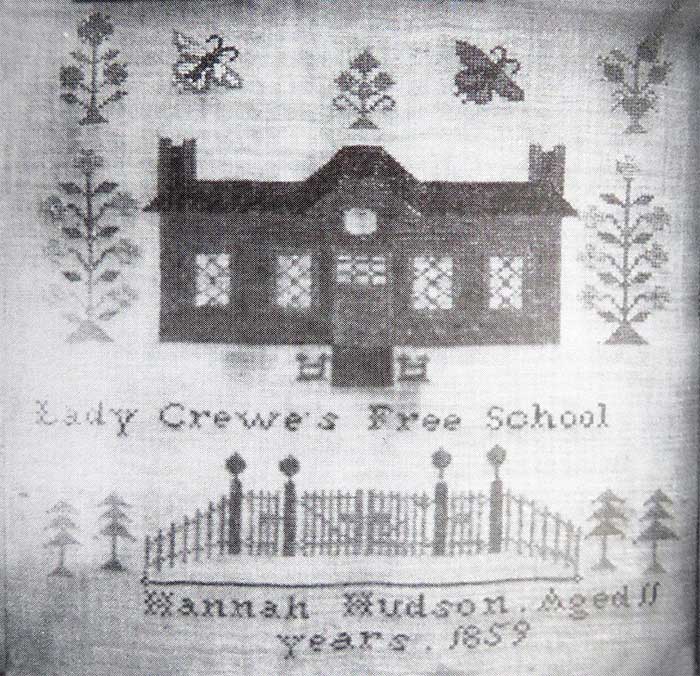 Needlework sampler by Hannah Hudson, 1859
Needlework sampler by Hannah Hudson, 1859The whereabouts Hannah’s needlework samplers is currently unknown
Leslie Cox noted that ‘after a short period at the Whimsey, the family moved to The Kennels, another keepers cottage a short distance away’ and that in 1860 the family moved again, to Ferry House in Twyford, which would ‘remain the family home for the next ninety years...
‘Hannah completed her formal education at Lady Crewe’s school, but this was supplemented by considerable reading, which was always encouraged by her parents, and she became a student of the Bible.’
After leaving school, Hannah worked as a housemaid at Calke Abbey. The steward’s account book for Calke shows that Hannah received £5 on 31st December 1870, being wages for half a year.
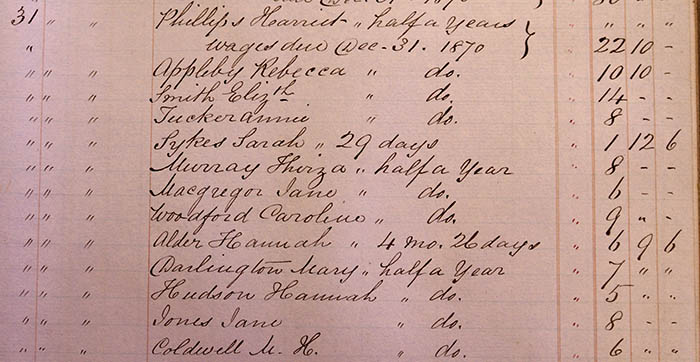 Extract from the steward’s account book of Calke Abbey
Extract from the steward’s account book of Calke Abbey
Hannah was still working at Calke Abbey in April 1871, with the census return listing her as one of several servants. She is recorded on the same page as Sir John Harpur Crewe and his family.
In 1879 Hannah wrote a solemn poem about a tragic event in 1840 when her grandparents John and Martha Hudson lost their 15 year old son William. He was missing for several days, until his body was found beneath an iced over pond at Calke. Called The Lost Ones, it tells of the anguish her grandparents would have suffered during the search for their son, and can be found in the library section.
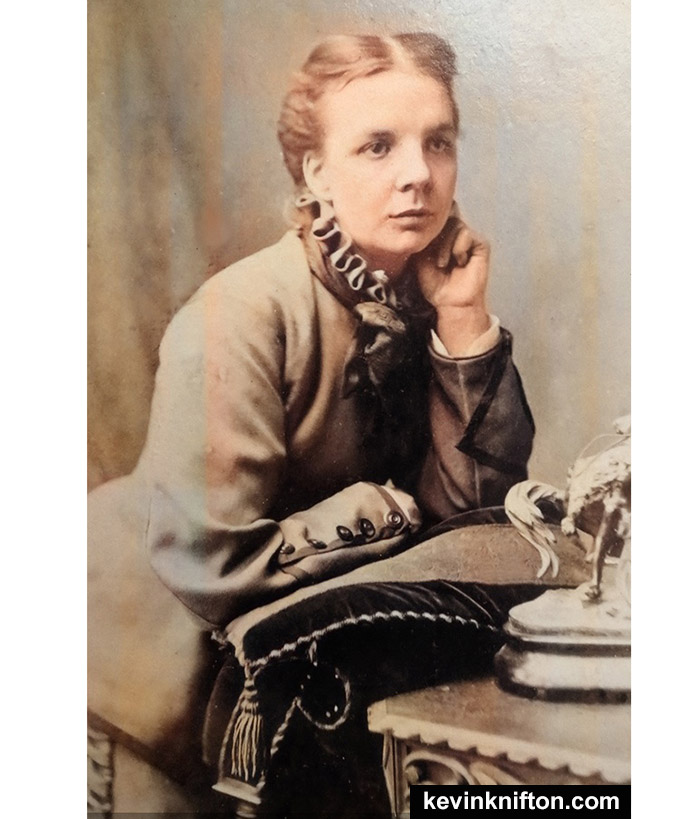 Hannah Hudson, circa 1877
Hannah Hudson, circa 1877
In April 1881, Hannah was living in Clitheroe, Lancashire, and was working at St Paul’s Street Vicarage as a cook to Reverend Waddington and his family.
Between 1881 and 1891 Hannah moved to the vicarage at Alstonfield in Ashbourne, Derbyshire, the home of William Henry Purchas, Vicar of Alstonfield, and his family. William Henry Purchas’ connection to Calke began in 1857 when he was appointed chaplain at Ticknall. He moved to Gloucestershire in 1865, but in 1870 Sir John Harpur Crew appointed him as vicar of Alstonfield, which was part of the Harpur Crewe Estate. It is likely that William knew Hannah from his time at Calke.
Leslie Cox noted that Hannah joined the family at Alstonfield vicarage as a nursery maid. William was a widower by 1881 and his youngest two children were 13 and 15. By 1891 the youngest child was 23. As the children grew up, Hannah changed her role, and the census returns for 1891 and 1901 record her occupation as a cook. Hannah ‘entered fully into the life of the family and the village, and over the years provided valuable assistance to the vicar, both in the household and in his parish duties. From her religious upbringing she had developed a deep personal faith. She had complete trust in God’s purpose for herself and for all mankind. She had, however, no illusions about the practical problems of living, and had her feet firmly on the ground...if anyone was sick, a call from the vicar would be followed by a visit from Hannah with beef tea or a custard for the patient.’ William Purchas is also said to have taught Hannah the rudiments of Latin.
In his book, Leslie Cox2 wrote that ‘close contact was kept with Calke Abbey, and members of the Harpur Crewe family would regularly visit Alstonfield...Each autumn, the whole family would move from Calke Abbey to their north Staffordshire residence, Warslow Hall, for the grouse shooting season. On one occasion, Lady Crewe was over from Calke presiding at the vicarage over a committee of ladies, deciding on the distribution of blankets for the winter to elderly ladies of Alstonfield living alone.’ His notes continue: ‘The committee was on the point of removing from the list, one lady who had apparently had an illegitimate child in her youth. Lady Crewe, always compassionate, was not happy about this but did not wish to go against the committee. She turned to Hannah for advice. “Well milady, I consider that no matter what she did when she was young, she will still need keeping warm this winter.” “Quite right, Hannah” replied Lady Crewe. “She shall have the blankets”, and the committee’s decision was promptly overruled.’
Leslie also noted another occasion when Sir Vauncey Crewe opened a garden fete at Alstonfield. ‘Hannah bought him a pound of tomatoes from one of the stalls. Sir Vauncey was touched by this gesture and thanked her profusely. “You see” said Hannah afterwards, “everybody thinks that Sir Vauncey has got everything so nobody ever bothers to give him anything”’.
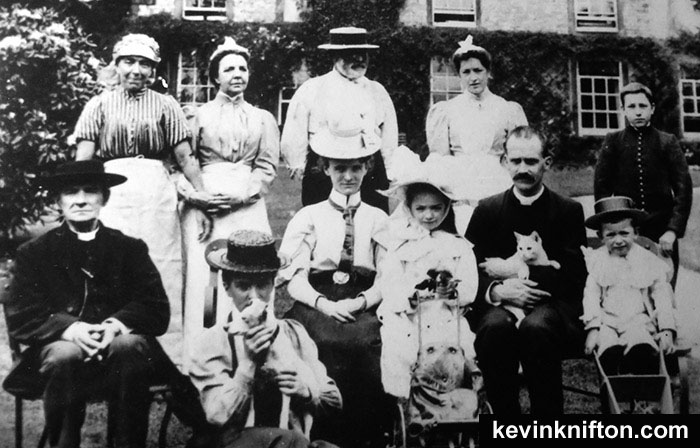 Hannah Hudson with the Purchas family.
Hannah Hudson with the Purchas family.The Vicarage, Alstonfield, Derbyshire
‘Hannah had a great sense of humour’ wrote Leslie. ‘She used to tell the story of the day, soon after her arrival at Alstonfield, when she went by carrier’s cart on her first visit to Buxton. When the time came to return, she found she was late, and was not sure of the way to a public house called the Cheshire Cheese, from where the carrier’s cart was due to leave for the return journey home. As she was hurrying along the street, she stopped to ask a man the way to the Cheshire Cheese. Mistaking Hannah, of all people, for a lady of ill repute, he began to lecture her about stopping men in the street. Hannah had no time to explain, and taking a religious tract from the supply she kept in her handbag, she thrust it into his hand as she hurried on her way.
‘On Sundays, Hannah led the singing in Alstonfield Church, in her deep and distinctive, slow and measured voice, and the vicar took care that the congregation kept to her pace, particularly during the singing of the canticles. During the summer months, in the country districts, Irish labourers would arrive, complete with sickles to help with the harvest. At Alstonfield, as Roman Catholics, they could not attend the village church, and their own church at Ashbourne was too far away. Each Sunday, Hannah, with the approval of Mr Purchas, would hold a simple service for the men on the village green, or in a barn if the weather was wet. The men would sing hymns, and Hannah would lead them in prayer and give a short address.’
Hannah was always busy, either in the vicarage household, or in the parish. Leslie noted that ‘Hannah once remarked in jocular mood “When I get to Heaven, I hope I do not meet the vicar, for he is sure to find me a job to do”’.
On 15th January 1898, William Purchas is said to have held a special tea at the vicarage to celebrate Hannah’s fiftieth birthday. Leslie noted that William ‘called it her “jubilee” and presented her with a studio photograph of herself’.
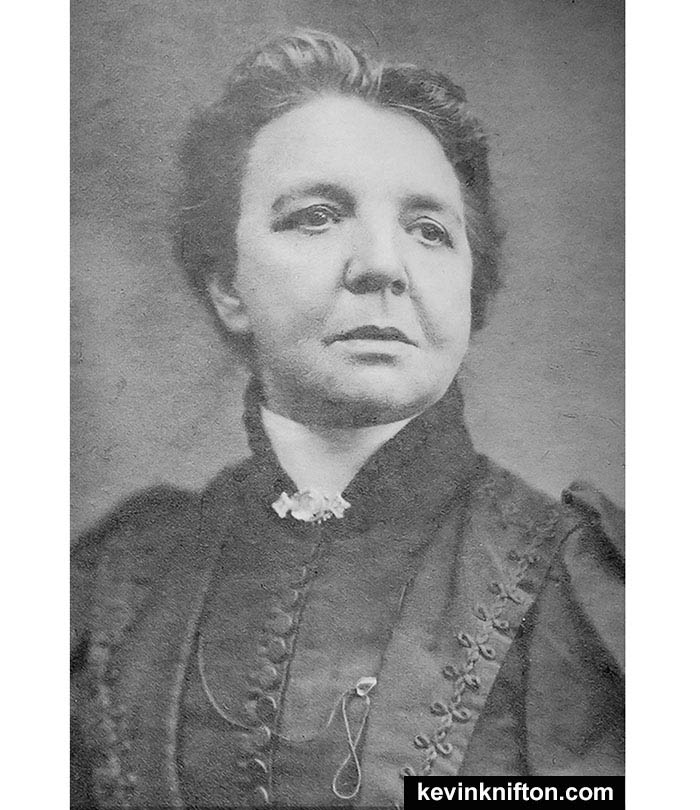 Hannah Hudson, circa 1898
Hannah Hudson, circa 1898
Hannah is known to have written a number of poems, including Day Dreams which, according to the notes of Leslie Cox, ‘recalls childhood days at Wicket Nook in which places and people are placed in a biblical situation. There are other versus about family life at Twyford and village life at Alstonfield in North Staffordshire.’ It is not known if this poem survives; Hannah's poems may have been captured by her brother William in his diary, but the location of this is also unknown.
William Henry Purchas died on 16th December 1903. He signed his Will on 15th July 1897 but on 9th August 1900 he signed a codicil which amended the bequests to his daughters. One of the witnesses to this codicil was Hannah Hudson, ‘Domestic Servant’, while the other was Tudor Williams, ‘Gentleman’.
Leslie Cox noted that Arthur, William Purcha’s son who had been the curate at Alstonfield, became curate at St Luke’s Church, Bedminster ‘and Hannah went with him to help in the house and with the parish duties... Hannah soon found herself involved in evangelical and social work connected with St Luke’s parish. Drunkenness and lawlessness were rife, but Hannah was never afraid to become involved in any situation. The work was a challenge and she became a familiar figure in her long black cloak and a Bible under her arm...and distributing soup from the soup kitchen to the deserving poor of Bedminster. When recalling these days she would say that she had received a marriage proposal from many a drunken man!’
Leslie wrote that ‘in 1910 Arthur Purchas became a rector of Stocking Pelham, a tiny hamlet in Hertfordshire, and Hannah accompanied him to assist as before.’
We do not know when Hannah left Hertfordshire. The 1911 census return records that the Reverend Arthur Purchase and his wife Mary were still living at Stocking Pelham, employing a ‘house parlour maid’. Hannah is also at the house, described as a visitor in relation to Arthur, and her occupation is recorded as ‘district visitor’.
At some point Hannah moved to Tissington, ten miles south of Alstonfield, and lived with a her older sister Caroline, who was widowed in 1912. Leslie noted that at Tissington Hannah ‘was much in demand in the district, and with a talent for preaching, would take service in the local Methodist Chapel, often at short notice’.
Hannah died at Tissington on 27th February 1916, aged 68.
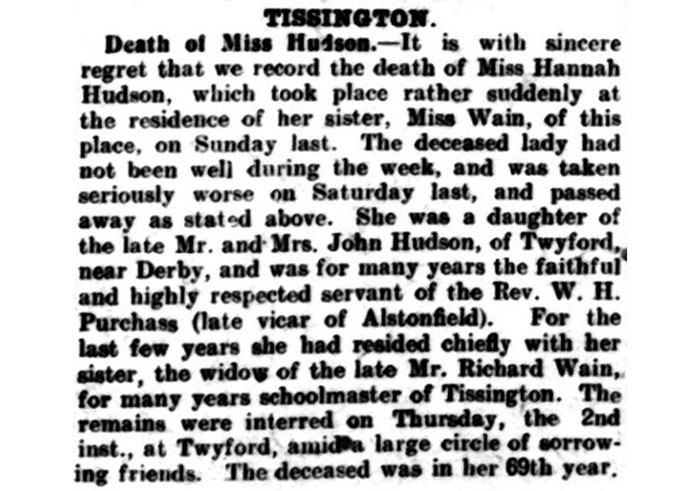
In his book, Leslie Cox wrote that Hannah ‘was brought to the old home at Twyford for burial. On the day of her funeral, the river Trent had burst its banks, making the road to the church impassable, and Hannah’s coffin had to be carried across the fields.’ Hannah was buried on 2nd March in the churchyard at St Andrew’s Church, Twyford. She died intestate.
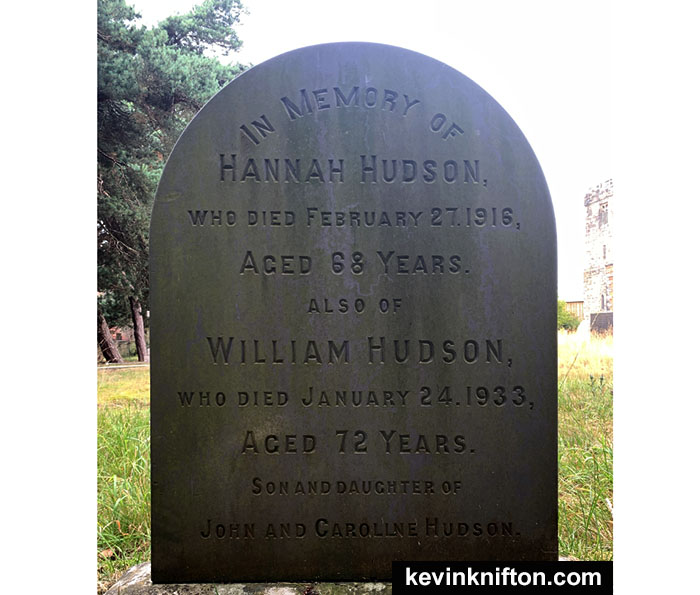 ‘In memory of Hannah Hudson, who died February 27, 1916, aged 68 years. Also of William Hudson, who died January 24, 1933, aged 72 years. Son and Daughter of John and Caroline Hudson.’
‘In memory of Hannah Hudson, who died February 27, 1916, aged 68 years. Also of William Hudson, who died January 24, 1933, aged 72 years. Son and Daughter of John and Caroline Hudson.’
Hannah Hudson was my great-great-grandaunt.
1 Leslie Carl Cox 1923-2011
2 L. J. Cox, Over the Hills to Calke: 150 Years of Memories of Calke Abbey and the Harpur-Crewes (2000), Chapter 9.